UV Spectroscopy Method Validation for Carotene Extraction Report
VerifiedAdded on 2021/04/21
|13
|1336
|228
Report
AI Summary
This report details the validation of a UV spectroscopy method for carotene extraction. It outlines the methodology, including assessments of accuracy, precision (method and intermediate), specificity, linearity, range, limit of quantitation, and robustness. The report explores the principles of UV spectroscopy, providing background information on the process of carotene extraction and the role of carotenes, particularly beta-carotene, as a source of Vitamin A. The analysis involves data collection, data analysis, and the drawing of inferences to determine the suitability of the UV spectroscopy method. The report includes tables for data representation, and concludes with recommendations based on the robustness of the method, including attachments and notes.
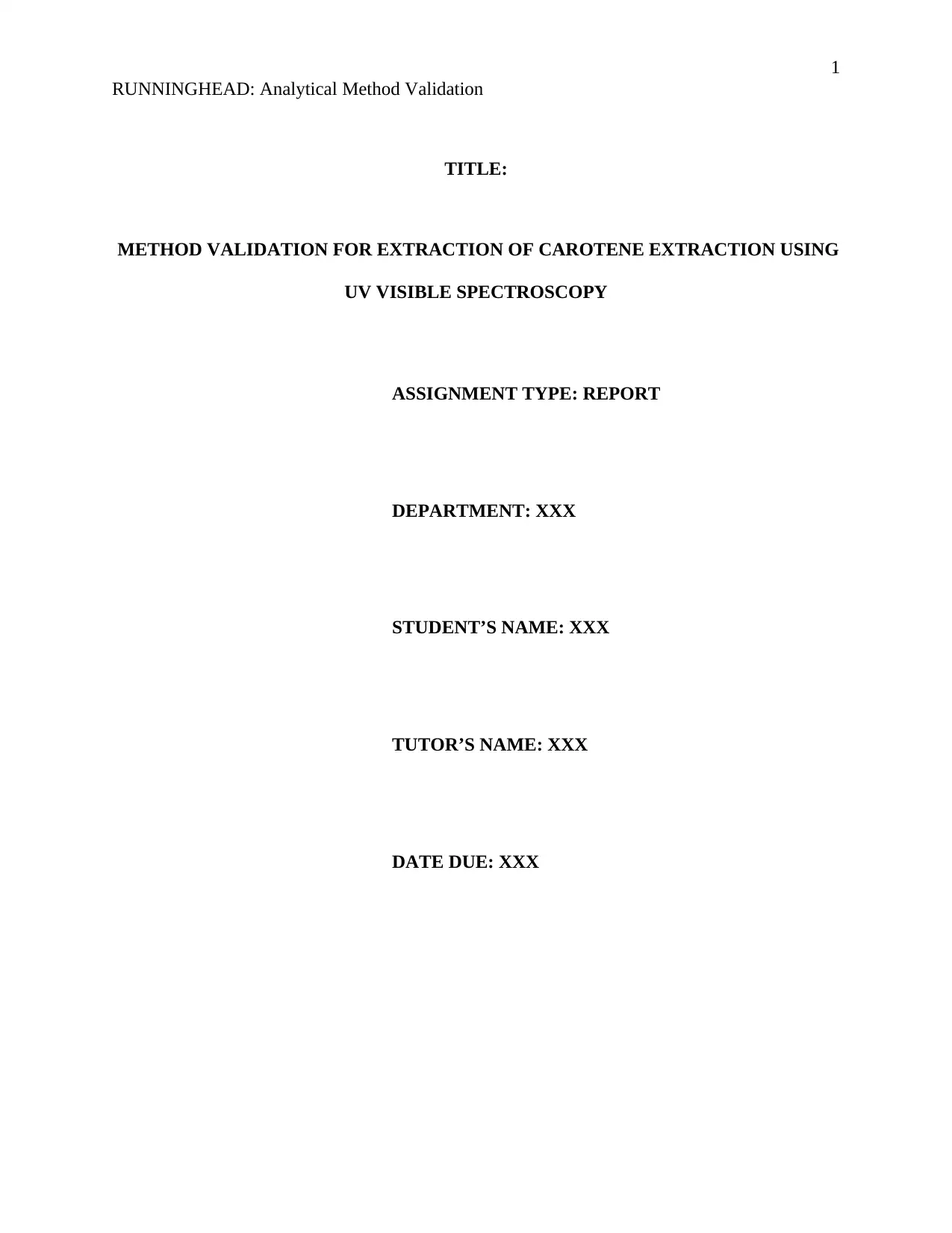
1
RUNNINGHEAD: Analytical Method Validation
TITLE:
METHOD VALIDATION FOR EXTRACTION OF CAROTENE EXTRACTION USING
UV VISIBLE SPECTROSCOPY
ASSIGNMENT TYPE: REPORT
DEPARTMENT: XXX
STUDENT’S NAME: XXX
TUTOR’S NAME: XXX
DATE DUE: XXX
RUNNINGHEAD: Analytical Method Validation
TITLE:
METHOD VALIDATION FOR EXTRACTION OF CAROTENE EXTRACTION USING
UV VISIBLE SPECTROSCOPY
ASSIGNMENT TYPE: REPORT
DEPARTMENT: XXX
STUDENT’S NAME: XXX
TUTOR’S NAME: XXX
DATE DUE: XXX
Paraphrase This Document
Need a fresh take? Get an instant paraphrase of this document with our AI Paraphraser
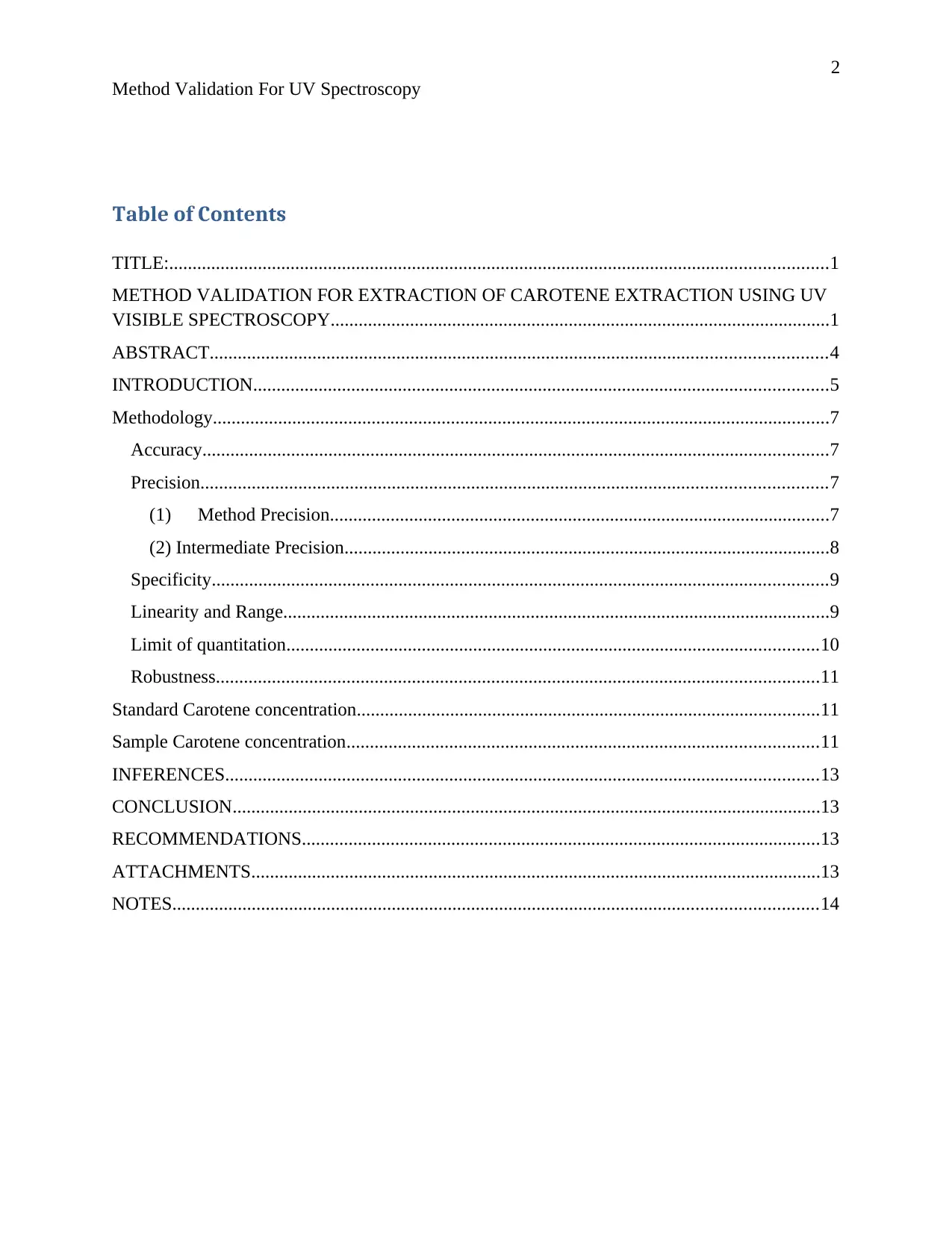
2
Method Validation For UV Spectroscopy
Table of Contents
TITLE:.............................................................................................................................................1
METHOD VALIDATION FOR EXTRACTION OF CAROTENE EXTRACTION USING UV
VISIBLE SPECTROSCOPY...........................................................................................................1
ABSTRACT....................................................................................................................................4
INTRODUCTION...........................................................................................................................5
Methodology....................................................................................................................................7
Accuracy......................................................................................................................................7
Precision......................................................................................................................................7
(1) Method Precision...........................................................................................................7
(2) Intermediate Precision........................................................................................................8
Specificity....................................................................................................................................9
Linearity and Range.....................................................................................................................9
Limit of quantitation..................................................................................................................10
Robustness.................................................................................................................................11
Standard Carotene concentration...................................................................................................11
Sample Carotene concentration.....................................................................................................11
INFERENCES...............................................................................................................................13
CONCLUSION..............................................................................................................................13
RECOMMENDATIONS...............................................................................................................13
ATTACHMENTS..........................................................................................................................13
NOTES..........................................................................................................................................14
Method Validation For UV Spectroscopy
Table of Contents
TITLE:.............................................................................................................................................1
METHOD VALIDATION FOR EXTRACTION OF CAROTENE EXTRACTION USING UV
VISIBLE SPECTROSCOPY...........................................................................................................1
ABSTRACT....................................................................................................................................4
INTRODUCTION...........................................................................................................................5
Methodology....................................................................................................................................7
Accuracy......................................................................................................................................7
Precision......................................................................................................................................7
(1) Method Precision...........................................................................................................7
(2) Intermediate Precision........................................................................................................8
Specificity....................................................................................................................................9
Linearity and Range.....................................................................................................................9
Limit of quantitation..................................................................................................................10
Robustness.................................................................................................................................11
Standard Carotene concentration...................................................................................................11
Sample Carotene concentration.....................................................................................................11
INFERENCES...............................................................................................................................13
CONCLUSION..............................................................................................................................13
RECOMMENDATIONS...............................................................................................................13
ATTACHMENTS..........................................................................................................................13
NOTES..........................................................................................................................................14
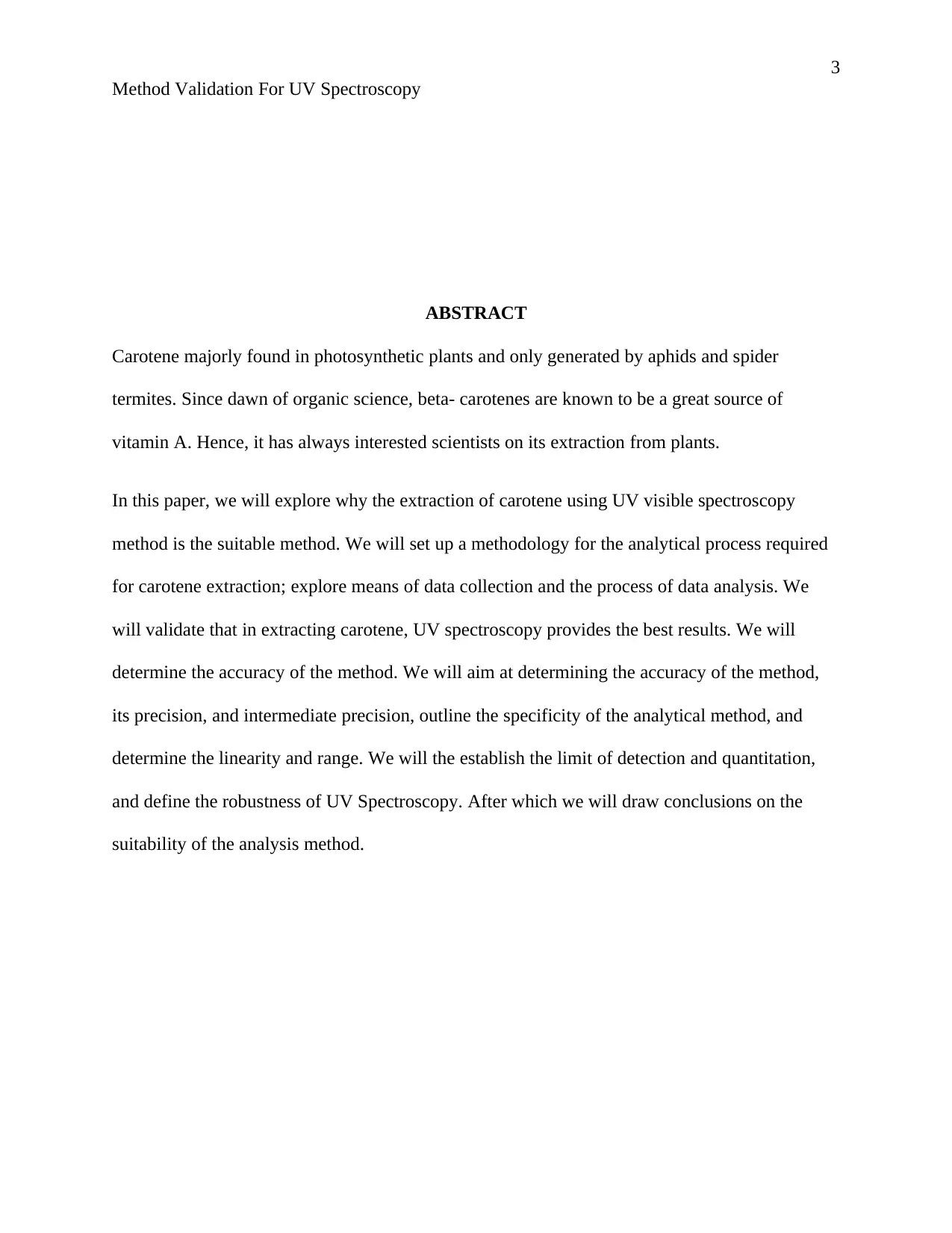
3
Method Validation For UV Spectroscopy
ABSTRACT
Carotene majorly found in photosynthetic plants and only generated by aphids and spider
termites. Since dawn of organic science, beta- carotenes are known to be a great source of
vitamin A. Hence, it has always interested scientists on its extraction from plants.
In this paper, we will explore why the extraction of carotene using UV visible spectroscopy
method is the suitable method. We will set up a methodology for the analytical process required
for carotene extraction; explore means of data collection and the process of data analysis. We
will validate that in extracting carotene, UV spectroscopy provides the best results. We will
determine the accuracy of the method. We will aim at determining the accuracy of the method,
its precision, and intermediate precision, outline the specificity of the analytical method, and
determine the linearity and range. We will the establish the limit of detection and quantitation,
and define the robustness of UV Spectroscopy. After which we will draw conclusions on the
suitability of the analysis method.
Method Validation For UV Spectroscopy
ABSTRACT
Carotene majorly found in photosynthetic plants and only generated by aphids and spider
termites. Since dawn of organic science, beta- carotenes are known to be a great source of
vitamin A. Hence, it has always interested scientists on its extraction from plants.
In this paper, we will explore why the extraction of carotene using UV visible spectroscopy
method is the suitable method. We will set up a methodology for the analytical process required
for carotene extraction; explore means of data collection and the process of data analysis. We
will validate that in extracting carotene, UV spectroscopy provides the best results. We will
determine the accuracy of the method. We will aim at determining the accuracy of the method,
its precision, and intermediate precision, outline the specificity of the analytical method, and
determine the linearity and range. We will the establish the limit of detection and quantitation,
and define the robustness of UV Spectroscopy. After which we will draw conclusions on the
suitability of the analysis method.
⊘ This is a preview!⊘
Do you want full access?
Subscribe today to unlock all pages.

Trusted by 1+ million students worldwide

4
Method Validation For UV Spectroscopy
INTRODUCTION
Healthy vision, a boast in neurological processes, and a healthy skin: These constitute some of
the benefits of Vitamin A whose primary source is Carotenes.i
Over the years, a number of methods have evolved in:
i. biochemical analyses
ii. environmental studies,
iii. forensic science,
iv. drug kinetics,
v. food quality,
vi. identification,
vii. Chemical detection in biological substances.
These include infrared and nuclear magnetic resonance and UV Spectroscopy, which is useful in
the study of reaction kinetics and equilibrium.ii
Method Validation For UV Spectroscopy
INTRODUCTION
Healthy vision, a boast in neurological processes, and a healthy skin: These constitute some of
the benefits of Vitamin A whose primary source is Carotenes.i
Over the years, a number of methods have evolved in:
i. biochemical analyses
ii. environmental studies,
iii. forensic science,
iv. drug kinetics,
v. food quality,
vi. identification,
vii. Chemical detection in biological substances.
These include infrared and nuclear magnetic resonance and UV Spectroscopy, which is useful in
the study of reaction kinetics and equilibrium.ii
Paraphrase This Document
Need a fresh take? Get an instant paraphrase of this document with our AI Paraphraser
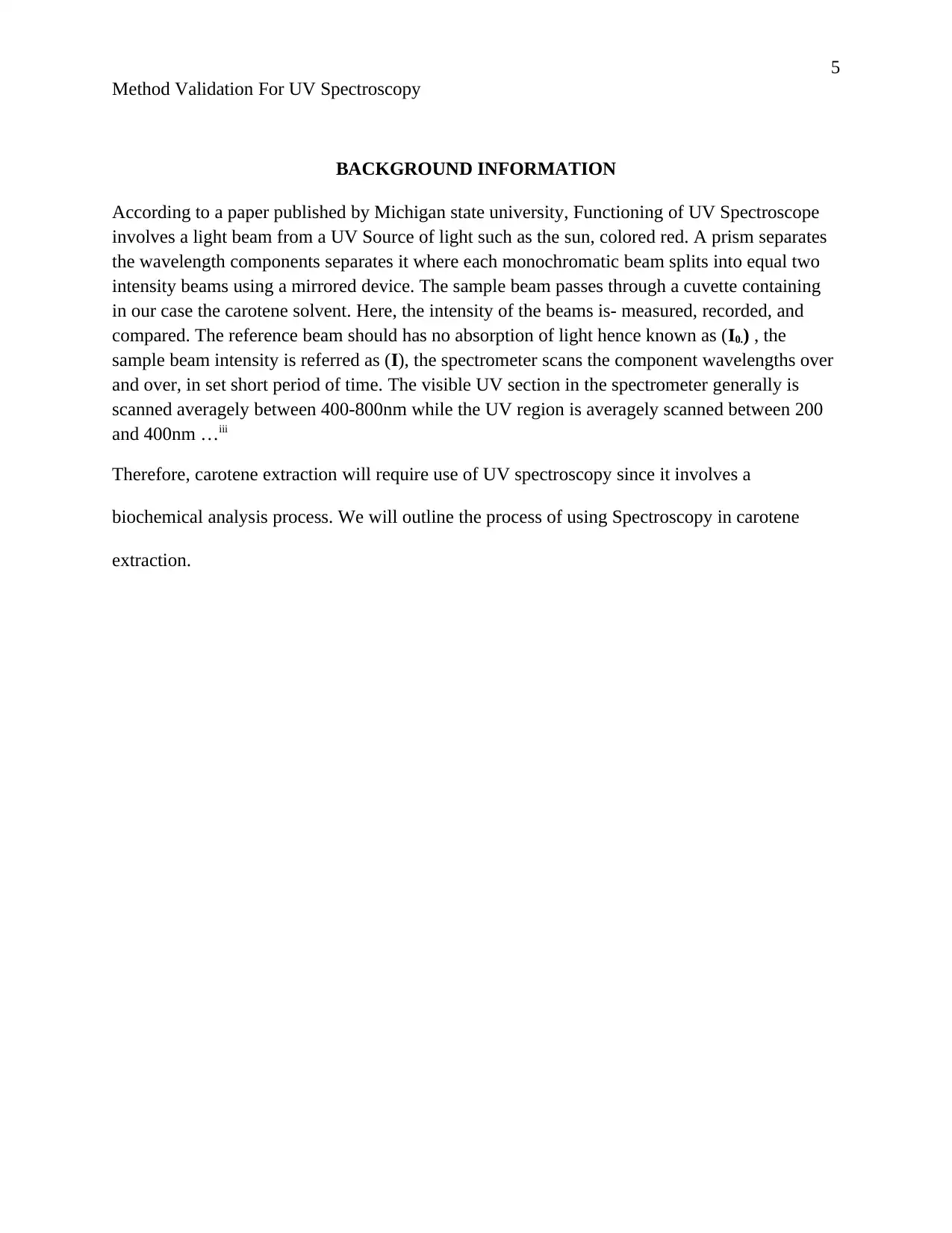
5
Method Validation For UV Spectroscopy
BACKGROUND INFORMATION
According to a paper published by Michigan state university, Functioning of UV Spectroscope
involves a light beam from a UV Source of light such as the sun, colored red. A prism separates
the wavelength components separates it where each monochromatic beam splits into equal two
intensity beams using a mirrored device. The sample beam passes through a cuvette containing
in our case the carotene solvent. Here, the intensity of the beams is- measured, recorded, and
compared. The reference beam should has no absorption of light hence known as (I0.) , the
sample beam intensity is referred as (I), the spectrometer scans the component wavelengths over
and over, in set short period of time. The visible UV section in the spectrometer generally is
scanned averagely between 400-800nm while the UV region is averagely scanned between 200
and 400nm …iii
Therefore, carotene extraction will require use of UV spectroscopy since it involves a
biochemical analysis process. We will outline the process of using Spectroscopy in carotene
extraction.
Method Validation For UV Spectroscopy
BACKGROUND INFORMATION
According to a paper published by Michigan state university, Functioning of UV Spectroscope
involves a light beam from a UV Source of light such as the sun, colored red. A prism separates
the wavelength components separates it where each monochromatic beam splits into equal two
intensity beams using a mirrored device. The sample beam passes through a cuvette containing
in our case the carotene solvent. Here, the intensity of the beams is- measured, recorded, and
compared. The reference beam should has no absorption of light hence known as (I0.) , the
sample beam intensity is referred as (I), the spectrometer scans the component wavelengths over
and over, in set short period of time. The visible UV section in the spectrometer generally is
scanned averagely between 400-800nm while the UV region is averagely scanned between 200
and 400nm …iii
Therefore, carotene extraction will require use of UV spectroscopy since it involves a
biochemical analysis process. We will outline the process of using Spectroscopy in carotene
extraction.
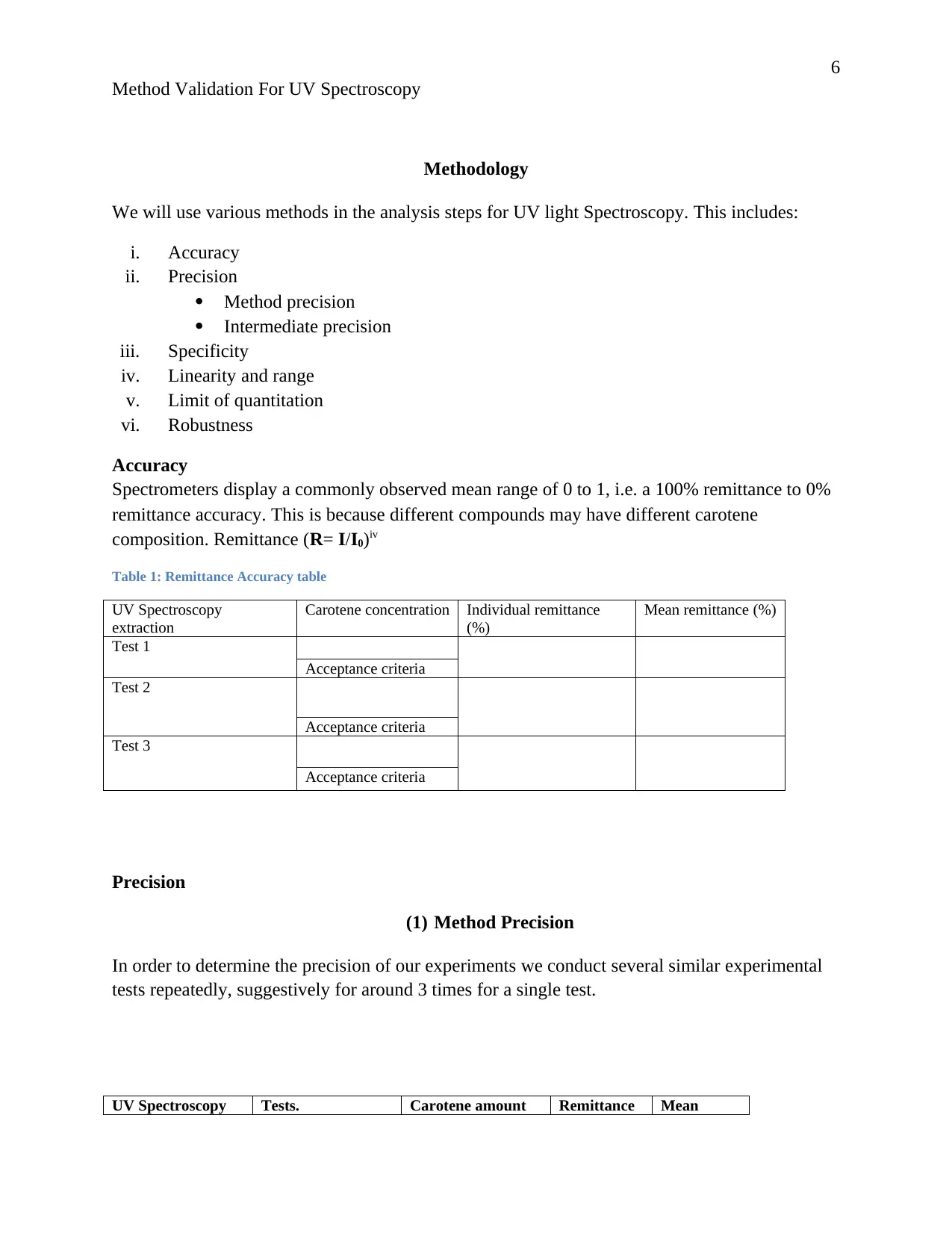
6
Method Validation For UV Spectroscopy
Methodology
We will use various methods in the analysis steps for UV light Spectroscopy. This includes:
i. Accuracy
ii. Precision
Method precision
Intermediate precision
iii. Specificity
iv. Linearity and range
v. Limit of quantitation
vi. Robustness
Accuracy
Spectrometers display a commonly observed mean range of 0 to 1, i.e. a 100% remittance to 0%
remittance accuracy. This is because different compounds may have different carotene
composition. Remittance (R= I/I0)iv
Table 1: Remittance Accuracy table
UV Spectroscopy
extraction
Carotene concentration Individual remittance
(%)
Mean remittance (%)
Test 1
Acceptance criteria
Test 2
Acceptance criteria
Test 3
Acceptance criteria
Precision
(1) Method Precision
In order to determine the precision of our experiments we conduct several similar experimental
tests repeatedly, suggestively for around 3 times for a single test.
UV Spectroscopy Tests. Carotene amount Remittance Mean
Method Validation For UV Spectroscopy
Methodology
We will use various methods in the analysis steps for UV light Spectroscopy. This includes:
i. Accuracy
ii. Precision
Method precision
Intermediate precision
iii. Specificity
iv. Linearity and range
v. Limit of quantitation
vi. Robustness
Accuracy
Spectrometers display a commonly observed mean range of 0 to 1, i.e. a 100% remittance to 0%
remittance accuracy. This is because different compounds may have different carotene
composition. Remittance (R= I/I0)iv
Table 1: Remittance Accuracy table
UV Spectroscopy
extraction
Carotene concentration Individual remittance
(%)
Mean remittance (%)
Test 1
Acceptance criteria
Test 2
Acceptance criteria
Test 3
Acceptance criteria
Precision
(1) Method Precision
In order to determine the precision of our experiments we conduct several similar experimental
tests repeatedly, suggestively for around 3 times for a single test.
UV Spectroscopy Tests. Carotene amount Remittance Mean
⊘ This is a preview!⊘
Do you want full access?
Subscribe today to unlock all pages.

Trusted by 1+ million students worldwide
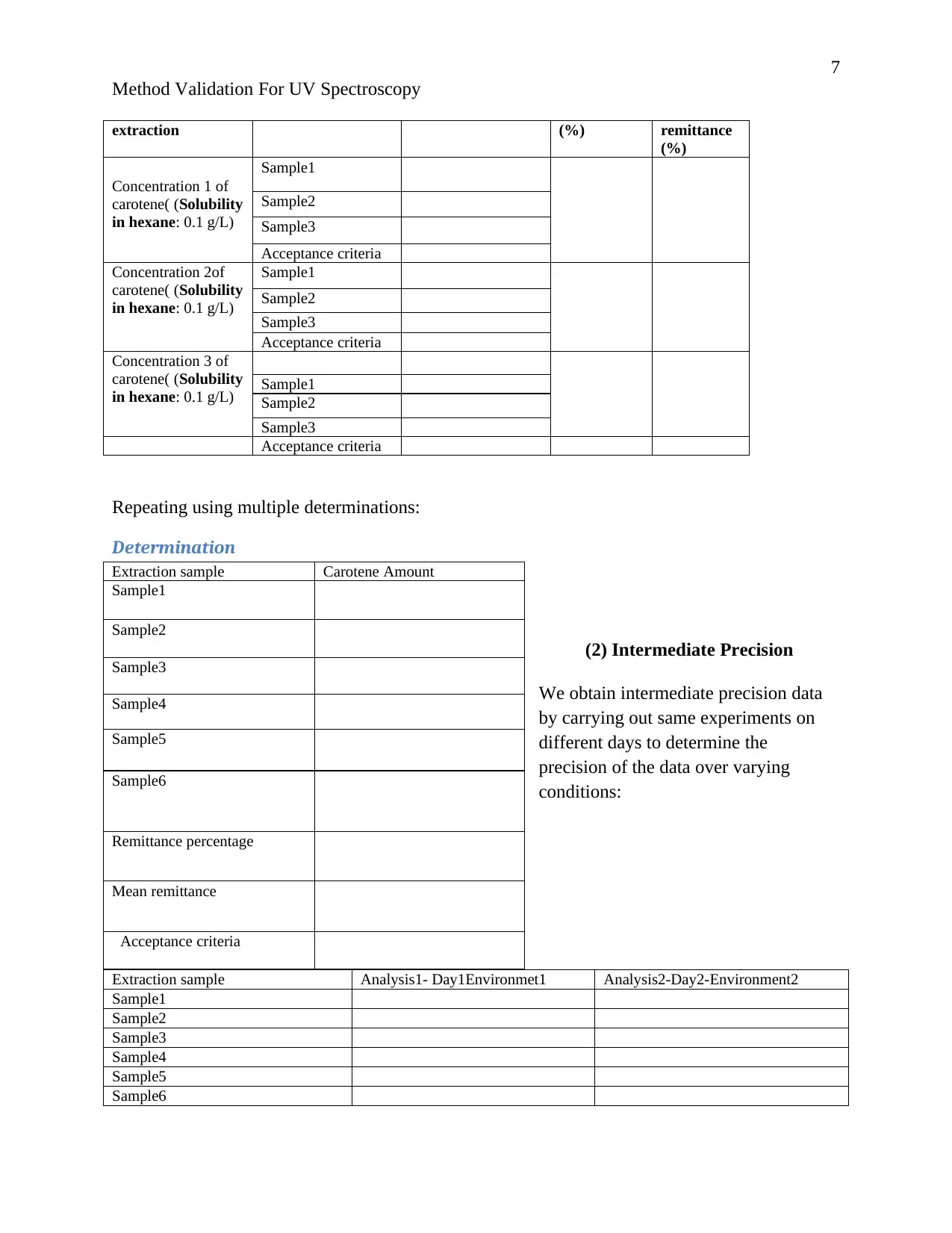
7
Method Validation For UV Spectroscopy
extraction (%) remittance
(%)
Concentration 1 of
carotene( (Solubility
in hexane: 0.1 g/L)
Sample1
Sample2
Sample3
Acceptance criteria
Concentration 2of
carotene( (Solubility
in hexane: 0.1 g/L)
Sample1
Sample2
Sample3
Acceptance criteria
Concentration 3 of
carotene( (Solubility
in hexane: 0.1 g/L) Sample1
Sample2
Sample3
Acceptance criteria
Repeating using multiple determinations:
Determination
(2) Intermediate Precision
We obtain intermediate precision data
by carrying out same experiments on
different days to determine the
precision of the data over varying
conditions:
Extraction sample Analysis1- Day1Environmet1 Analysis2-Day2-Environment2
Sample1
Sample2
Sample3
Sample4
Sample5
Sample6
Extraction sample Carotene Amount
Sample1
Sample2
Sample3
Sample4
Sample5
Sample6
Remittance percentage
Mean remittance
Acceptance criteria
Method Validation For UV Spectroscopy
extraction (%) remittance
(%)
Concentration 1 of
carotene( (Solubility
in hexane: 0.1 g/L)
Sample1
Sample2
Sample3
Acceptance criteria
Concentration 2of
carotene( (Solubility
in hexane: 0.1 g/L)
Sample1
Sample2
Sample3
Acceptance criteria
Concentration 3 of
carotene( (Solubility
in hexane: 0.1 g/L) Sample1
Sample2
Sample3
Acceptance criteria
Repeating using multiple determinations:
Determination
(2) Intermediate Precision
We obtain intermediate precision data
by carrying out same experiments on
different days to determine the
precision of the data over varying
conditions:
Extraction sample Analysis1- Day1Environmet1 Analysis2-Day2-Environment2
Sample1
Sample2
Sample3
Sample4
Sample5
Sample6
Extraction sample Carotene Amount
Sample1
Sample2
Sample3
Sample4
Sample5
Sample6
Remittance percentage
Mean remittance
Acceptance criteria
Paraphrase This Document
Need a fresh take? Get an instant paraphrase of this document with our AI Paraphraser
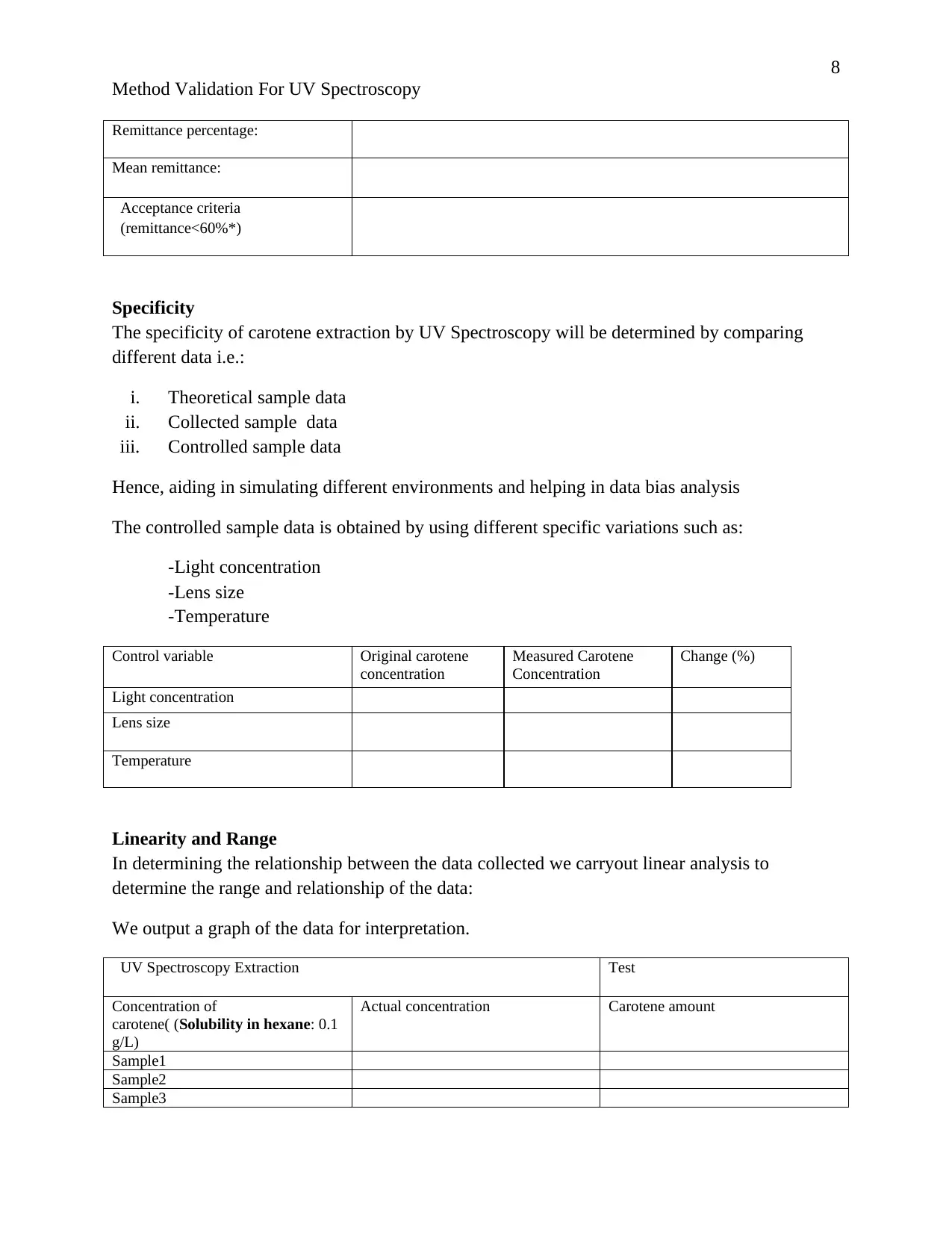
8
Method Validation For UV Spectroscopy
Remittance percentage:
Mean remittance:
Acceptance criteria
(remittance<60%*)
Specificity
The specificity of carotene extraction by UV Spectroscopy will be determined by comparing
different data i.e.:
i. Theoretical sample data
ii. Collected sample data
iii. Controlled sample data
Hence, aiding in simulating different environments and helping in data bias analysis
The controlled sample data is obtained by using different specific variations such as:
-Light concentration
-Lens size
-Temperature
Control variable Original carotene
concentration
Measured Carotene
Concentration
Change (%)
Light concentration
Lens size
Temperature
Linearity and Range
In determining the relationship between the data collected we carryout linear analysis to
determine the range and relationship of the data:
We output a graph of the data for interpretation.
UV Spectroscopy Extraction Test
Concentration of
carotene( (Solubility in hexane: 0.1
g/L)
Actual concentration Carotene amount
Sample1
Sample2
Sample3
Method Validation For UV Spectroscopy
Remittance percentage:
Mean remittance:
Acceptance criteria
(remittance<60%*)
Specificity
The specificity of carotene extraction by UV Spectroscopy will be determined by comparing
different data i.e.:
i. Theoretical sample data
ii. Collected sample data
iii. Controlled sample data
Hence, aiding in simulating different environments and helping in data bias analysis
The controlled sample data is obtained by using different specific variations such as:
-Light concentration
-Lens size
-Temperature
Control variable Original carotene
concentration
Measured Carotene
Concentration
Change (%)
Light concentration
Lens size
Temperature
Linearity and Range
In determining the relationship between the data collected we carryout linear analysis to
determine the range and relationship of the data:
We output a graph of the data for interpretation.
UV Spectroscopy Extraction Test
Concentration of
carotene( (Solubility in hexane: 0.1
g/L)
Actual concentration Carotene amount
Sample1
Sample2
Sample3
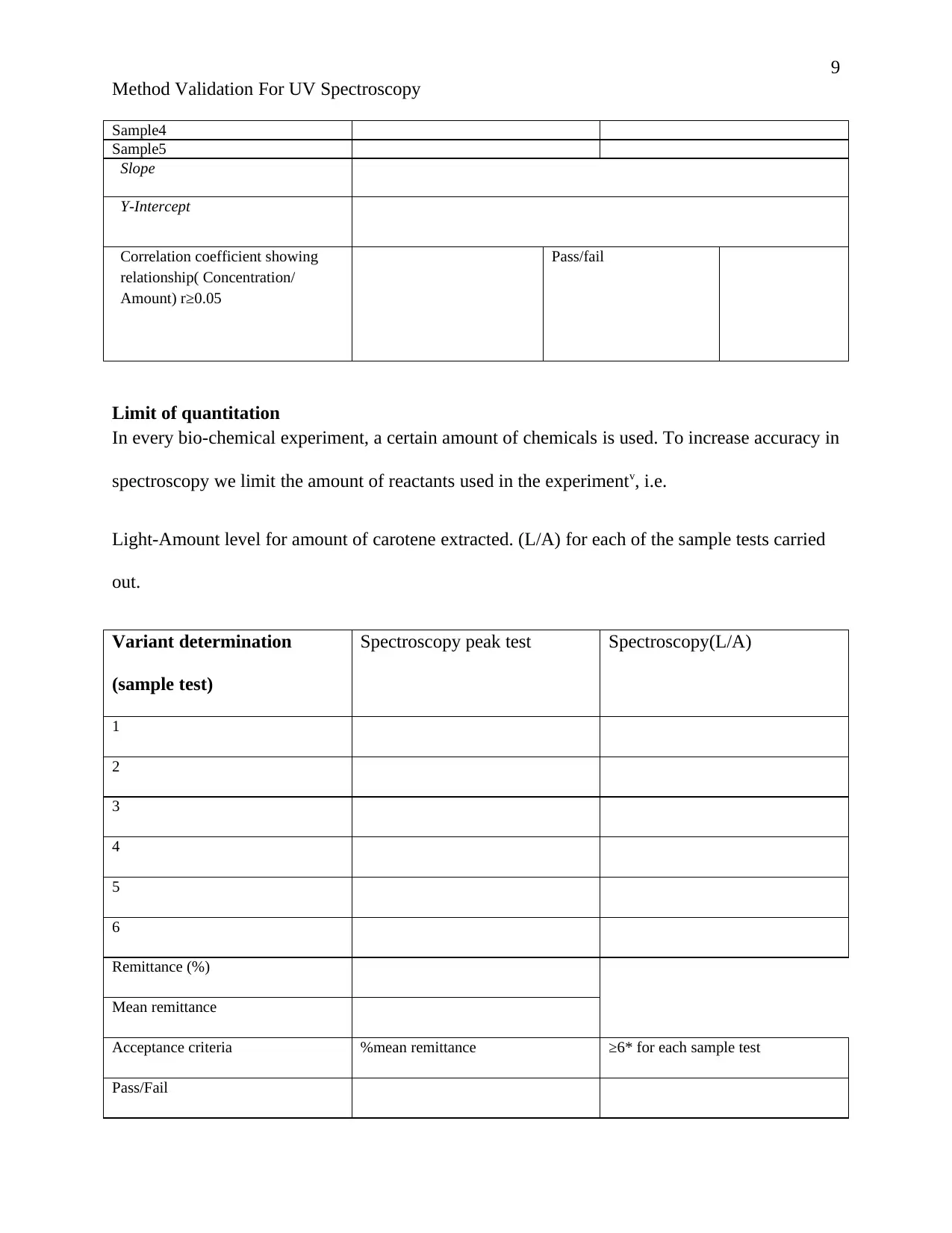
9
Method Validation For UV Spectroscopy
Sample4
Sample5
Slope
Y-Intercept
Correlation coefficient showing
relationship( Concentration/
Amount) r≥0.05
Pass/fail
Limit of quantitation
In every bio-chemical experiment, a certain amount of chemicals is used. To increase accuracy in
spectroscopy we limit the amount of reactants used in the experimentv, i.e.
Light-Amount level for amount of carotene extracted. (L/A) for each of the sample tests carried
out.
Variant determination
(sample test)
Spectroscopy peak test Spectroscopy(L/A)
1
2
3
4
5
6
Remittance (%)
Mean remittance
Acceptance criteria %mean remittance ≥6* for each sample test
Pass/Fail
Method Validation For UV Spectroscopy
Sample4
Sample5
Slope
Y-Intercept
Correlation coefficient showing
relationship( Concentration/
Amount) r≥0.05
Pass/fail
Limit of quantitation
In every bio-chemical experiment, a certain amount of chemicals is used. To increase accuracy in
spectroscopy we limit the amount of reactants used in the experimentv, i.e.
Light-Amount level for amount of carotene extracted. (L/A) for each of the sample tests carried
out.
Variant determination
(sample test)
Spectroscopy peak test Spectroscopy(L/A)
1
2
3
4
5
6
Remittance (%)
Mean remittance
Acceptance criteria %mean remittance ≥6* for each sample test
Pass/Fail
⊘ This is a preview!⊘
Do you want full access?
Subscribe today to unlock all pages.

Trusted by 1+ million students worldwide
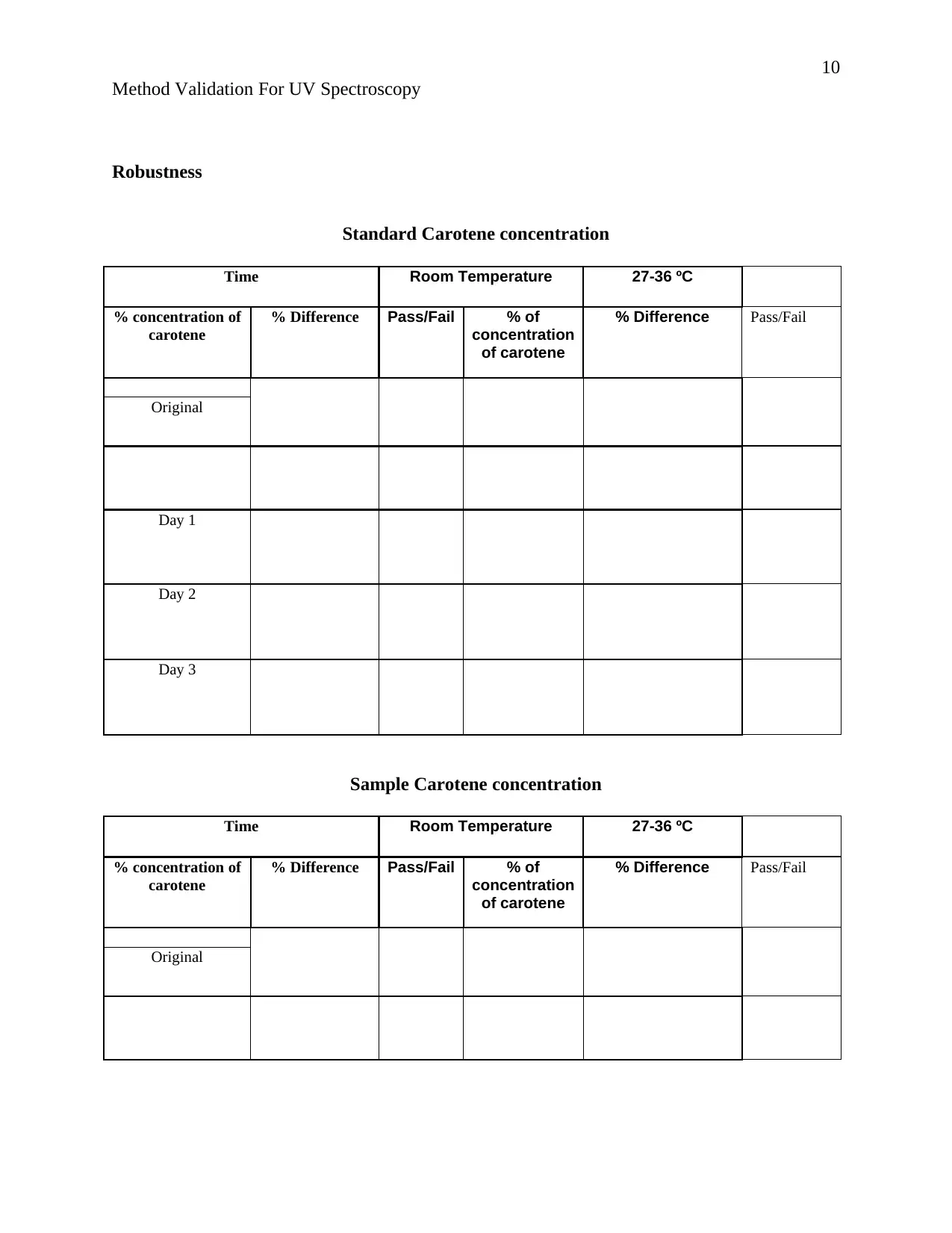
10
Method Validation For UV Spectroscopy
Robustness
Standard Carotene concentration
Time Room Temperature 27-36 ºC
% concentration of
carotene
% Difference Pass/Fail % of
concentration
of carotene
% Difference Pass/Fail
Original
Day 1
Day 2
Day 3
Sample Carotene concentration
Time Room Temperature 27-36 ºC
% concentration of
carotene
% Difference Pass/Fail % of
concentration
of carotene
% Difference Pass/Fail
Original
Method Validation For UV Spectroscopy
Robustness
Standard Carotene concentration
Time Room Temperature 27-36 ºC
% concentration of
carotene
% Difference Pass/Fail % of
concentration
of carotene
% Difference Pass/Fail
Original
Day 1
Day 2
Day 3
Sample Carotene concentration
Time Room Temperature 27-36 ºC
% concentration of
carotene
% Difference Pass/Fail % of
concentration
of carotene
% Difference Pass/Fail
Original
Paraphrase This Document
Need a fresh take? Get an instant paraphrase of this document with our AI Paraphraser
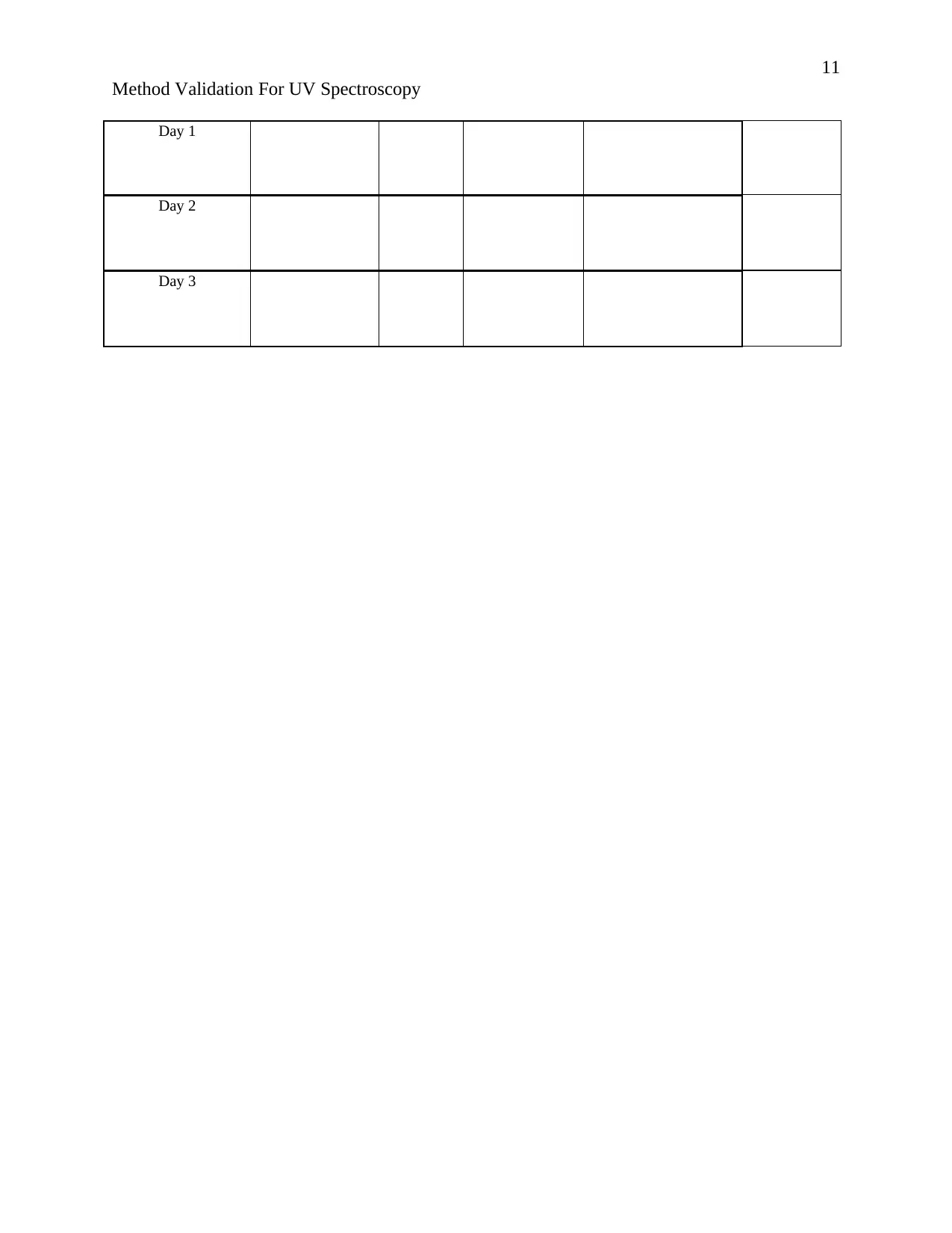
11
Method Validation For UV Spectroscopy
Day 1
Day 2
Day 3
Method Validation For UV Spectroscopy
Day 1
Day 2
Day 3

12
Method Validation For UV Spectroscopy
INFERENCES
The inferences are drawn from the analysis of the UV Spectroscopy experiment for carotene
extraction. These inferences are to used in reaching conclusions as to the suitability of the UV
Spectroscopy method.
CONCLUSION
In summary of the UV Spectroscopy for carotene extraction, we then determine whether the
Spectroscopy is appropriate for Carotene extraction given that the acceptance criterion is met. If
the amount of extracted carotene is more compared to other methods, we conclude that it is
suitable, among other dependent variables. i.e. simplicity.
RECOMMENDATIONS
Based on the results of the robustness of the UV Spectroscopy method for carotene extraction.
We then decide whether to recommend spectroscopy as a suitable extraction method, or, reject
the hypothesis. We analyze the robustness data to come into a decision for recommendation.
ATTACHMENTS
Attachments for our experiments are placed in the appendices, this include the collected data,
equipment list, chromatograms, figures as defined in presentation output and etcetera.
Method Validation For UV Spectroscopy
INFERENCES
The inferences are drawn from the analysis of the UV Spectroscopy experiment for carotene
extraction. These inferences are to used in reaching conclusions as to the suitability of the UV
Spectroscopy method.
CONCLUSION
In summary of the UV Spectroscopy for carotene extraction, we then determine whether the
Spectroscopy is appropriate for Carotene extraction given that the acceptance criterion is met. If
the amount of extracted carotene is more compared to other methods, we conclude that it is
suitable, among other dependent variables. i.e. simplicity.
RECOMMENDATIONS
Based on the results of the robustness of the UV Spectroscopy method for carotene extraction.
We then decide whether to recommend spectroscopy as a suitable extraction method, or, reject
the hypothesis. We analyze the robustness data to come into a decision for recommendation.
ATTACHMENTS
Attachments for our experiments are placed in the appendices, this include the collected data,
equipment list, chromatograms, figures as defined in presentation output and etcetera.
⊘ This is a preview!⊘
Do you want full access?
Subscribe today to unlock all pages.

Trusted by 1+ million students worldwide
1 out of 13